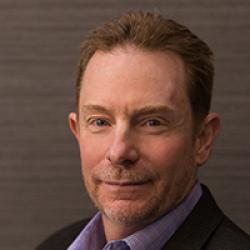They found their way to medical school along circuitous paths, propelled by life experiences their younger classmates can only imagine.
2nd Lt. Thomas O’Leary, 41, was an Army combat medic searching for his next career move to support his family. Kirsten Pickard, 41, had grown disenchanted with her telecommunications career and aspired to become a doctor after marrying one. Cat-Tuong Vu, 44, felt inspired by doctors whom he watched guide his wife through a frighteningly complicated pregnancy with their twins.
These students are part of a tiny cohort: medical students age 40 or above. From the 2000-01 through 2019-20 academic years, 1,143 such students matriculated into medical schools — comprising about 0.3% of the 375,188 total matriculants during that time span.
“Graduating at 50 was extreme, and there are days I wonder if I should have,” says Karen Thiele, MD, who left a nursing career. “But I enjoy the job. My family is proud of me. And it was one of the best days of my life when I walked across the stage.”
Older students tend to face challenges that differ in intensity and type from those of traditional medical students, but they also bring different assets.
First comes the Medical College Admission Test® (MCAT®) exam. Largely due to their long absence from college, admissions officers say, older students typically face particular struggles on the admissions test.
“It’s a lot of ground to make up,” says Athena R. Ganchorre, PhD, director of student development at the University of Arizona College of Medicine - Tucson. “They might never have taken a standardized test like the MCAT exam – it requires a way of thinking and testing that’s hard to learn in a short time.”
Nevertheless, admissions officers say they look favorably on many older applicants because they bring life skills that don’t show in test scores. They’ve juggled career and family responsibilities and built resilience by working through financial, professional, and personal ups and downs.
“Being able to balance between all of those things is a significant strength,” says Steven Gay, MD, assistant dean for admissions at the University of Michigan Medical School.
In school, older students often face special stressors, such as the loss of income from their previous careers, significantly less time with spouses and children at home, and the added pressure on their spouses to run the household. Managing family and school life demands all the time-management skills they’ve honed throughout adulthood, Gay says.
Their time away from the rigors of higher education can make their new academic demands especially daunting. A study of students who entered medical school after working as adults in other careers, published in the Southern Medical Journal last December, found that “career changer medical students show a small, persistent academic lag in the first 2 years of medical school,” but then catch up.
“There may be a curve where initially it’s harder to get their feet wet,” says Capt. Robert Liotta, MD, associate dean of recruitment and admissions at the Uniformed Services University’s F. Edward Hébert School of Medicine. “But once they figure out the way they need to study, they make those tweaks, then they go on a glide path and do very well.”
The path is eased by support networks that nontraditional students establish, providing everything from friendship and advice to parent-child activities, social events, and peer-led panel discussions. Some are informal virtual networks that students tap into as needed, while others are official clubs, such as the Student Spouses Club at Uniformed Services University, and a group for nontraditional students at Michigan called Winding Roads — so named, Gay says, “because it took a longer, winding road for them to get here.”
Once older students adjust, admissions officers say, they often emerge as leaders in their classes and excel in areas where younger students stumble. “Things that might worry a 20-something just kind of roll off them,” Ganchorre says. “They have extreme maturity.”
Several older students shared their stories with AAMCNews, including their tough times, strengths earned by age, and motivation to serve patients.
Kirsten Pickard
Age: 41
Status: First-year student
University of Arizona College of Medicine - Tucson
Tucson, Arizona
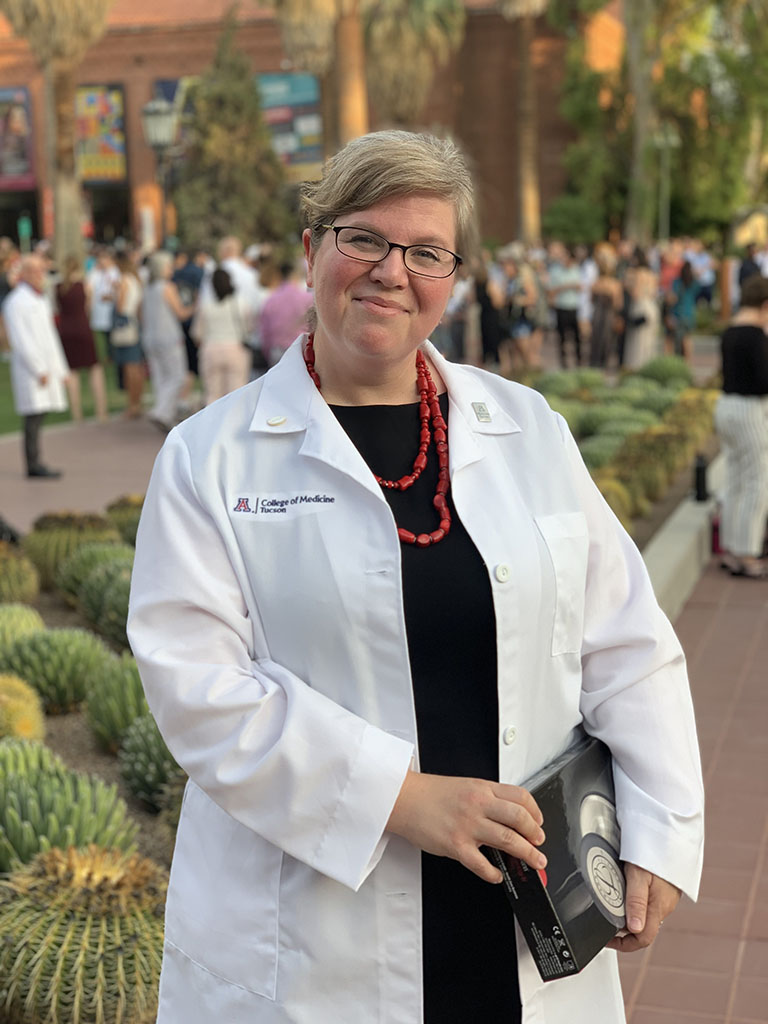
For most of her life, Kirsten Pickard had little interest in becoming a doctor.
“I thought about doctors as body mechanics,” she recalls. “You go in, you get a tune up and leave. So what?”
Then she married a doctor.
By the time Pickard met Joshua Sonkiss, MD — a forensic psychiatrist and addiction medicine physician — she had already earned a degree in journalism, left behind a career in telecommunications because the field had become less innovative, and given birth at 30. Motherhood, she said, stirred in her the feeling that “you are helping another person develop … giving them the support they need so they can be empowered to do things they want to do.”
That feeling was eventually channeled toward medicine. Pickard says she was influenced by her work as executive director for the Alaska branch of the American Psychiatric Association as well as seeing her husband and his colleagues “supporting their patients’ health in every way,” paying attention to physical health, mental health, and social determinants of health — “not just being a body mechanic.”
Still, Pickard worried about her capacity to succeed in medical school after being away from college for so long. “It had been nearly 20 years since I’d taken basic chemistry,” she says.
She took classes in biology and organic chemistry, then completed bachelor’s degrees in psychology and natural sciences before applying.
Pickard believes her job and parenting experience prepared her well to navigate the business and regulatory sides of health care and to solve conflicts with others through diplomacy and coalition-building.
Her biggest challenge lies in balancing school with parenting. “If one of my colleagues wants to sleep until 9, or work into the middle of the night, they can — but I’m up at 6 because my son’s up at 6,” she says. “My free time is already dedicated to helping with school projects or having a family game night.”
On the other hand, she says, “Having someone depend on you has a way of creating structure and focus.”
Cat-Tuong Vu
Age: 44
Status: First-year student
Paul L. Foster School of Medicine
Texas Tech University Health Sciences Center
El Paso, Texas
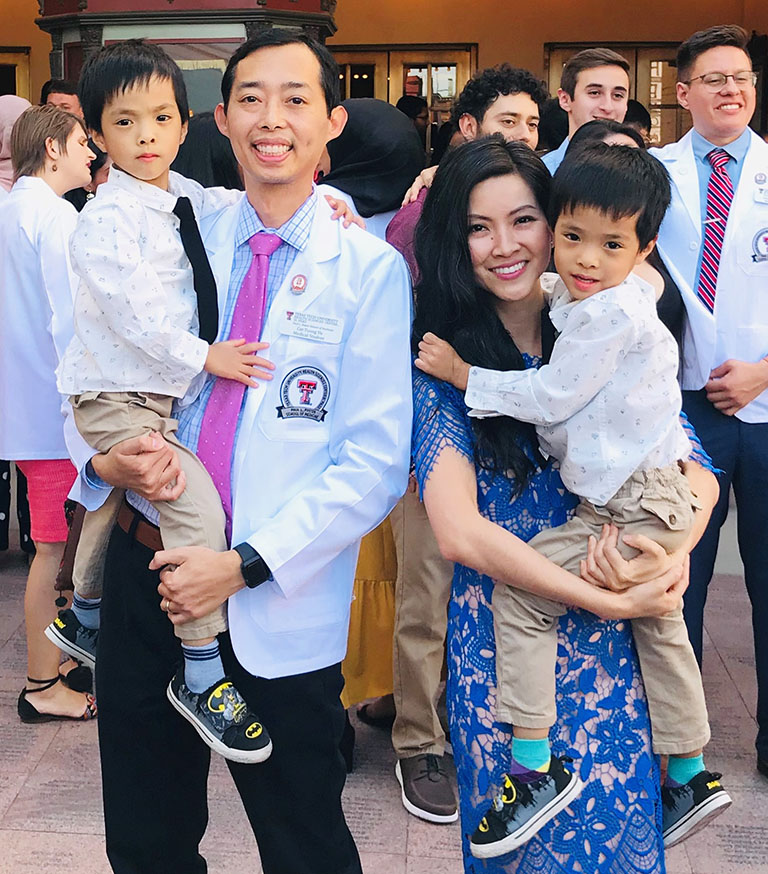
Cat-Tuong Vu explains his motivation for becoming a doctor in two words: “the doctors.”
He means the doctors who cared for his wife through a complicated pregnancy with twins, including three medical emergencies. During one harrowing stretch, Vu recalls, “I slept and ate in the hospital for a month. I got to experience firsthand these amazing doctors. I was so inspired.”
He decided to join them. After 15 years as a dentist, Vu applied to medical schools in 2016. He didn’t get accepted. After completing a one-year postbaccalaureate certificate program in biomedical sciences, he got in.
Among Vu’s first culture shocks was his technology gap with the younger students. They used an array of applications and programs “that made learning easier and more convenient.” The students got him up to speed on programs and resources to store notes in the cloud for easy access, annotate slides, and download flash card study sets created by other students.
“There are 30,000 Anki cards to get you ready for Step 1,” Vu says in awe of one application.
The standard time-management pressure of medical school is compounded by having twins at home. Vu tries to get his school work done while Luke and Liam (now 5) are in day care. “Once my kids get home, I try to set aside my time so I’m devoting most of my attention to them,” he says.
Medical school also affects his wife, Minh Vu. She switched from teaching at a middle school to an administrative position with a more flexible schedule so she could take on more family responsibilities. “She is the biggest reason why this is possible,” he says.
Vu finds advantages to starting medical school after maturing for a couple of extra decades.
“I used to be more timid,” he says. “I’m not embarrassed to say [to a teacher], ‘I don’t understand what you just said, can you explain?’ My younger self, if I didn’t understand anything, I’d probably be afraid to approach him.”
For adults thinking about medical school, Vu suggests envisioning themselves when their career days are done. “I pictured myself looking back at age 70,” he says. “I didn’t want to have any regrets.”
2nd Lt. Thomas O'Leary
Age: 41
Status: Fourth-year student
F. Edward Hébert School of Medicine
Uniformed Services University
Bethesda, Maryland
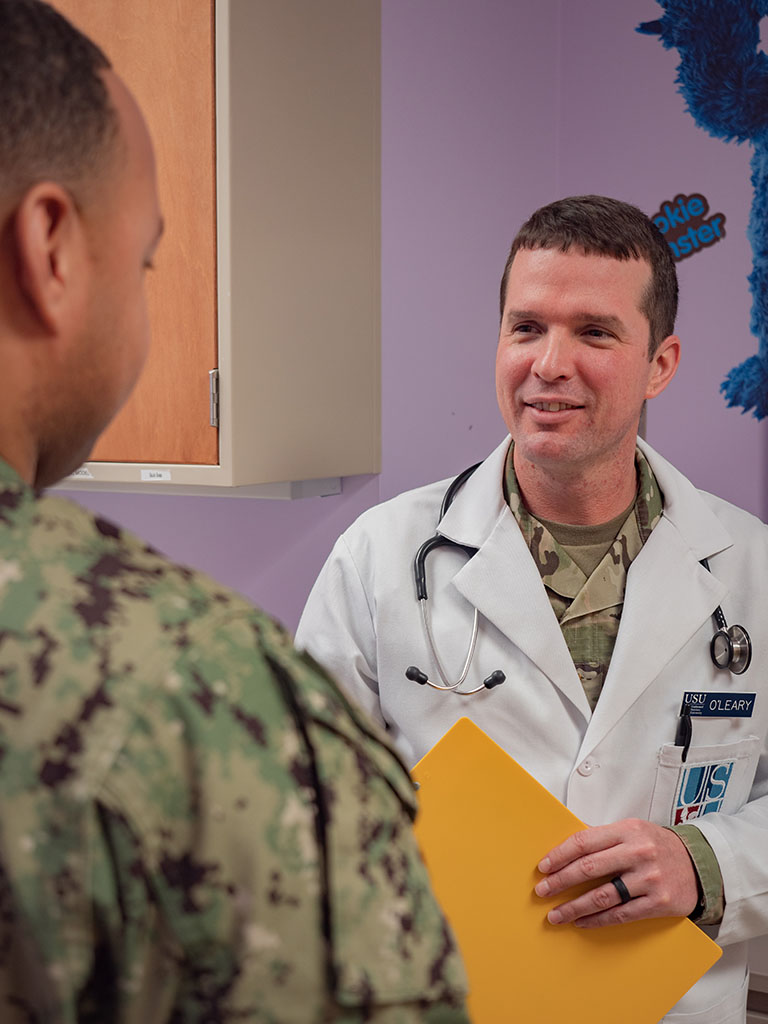
Thomas O’Leary is used to being “the old guy” in the group — like when he entered Army basic training at 33.
“They called me grandpa,” he says.
By then, O’Leary recognized a life pattern: “I’m late to arrive at a lot of things.”
He put off college for a few years after graduating high school, eventually earning undergraduate and graduate degrees in biodiversity ecology and evolutionary biology. He taught for a while at a community college in Kansas, got married in his early 30s, and sought a more stable career to support a family.
The military attracted him because it would provide great health care for him, his wife, and their future children. He joined the Army, served as an EMT, and while pondering his next steps, learned about the military’s Uniformed Services University medical school.
Not only would a career as a physician provide stability, but it would also make sense financially — the school is free (in exchange, students commit to military service), and he would continue drawing his military salary, a housing allowance, and free family health care. Thus, O’Leary speaks words seldom heard from medical students: “Coming to med school relieved a lot of financial stress.”
Still, he admits, “I felt old when I got there. A lot of them [the students] could be my children.”
One of the biggest adjustments, he says, “was trying to understand how these young people thought and acted, and what kind of behaviors they expected” — such as sending frequent emails and responding immediately. “I had to adjust to their expectations.”
Those younger students turned to him to learn about experiences and perspectives they didn’t have: serving in the military, having a career, and having a family.
His wife, Melissa, has taken on many of the family responsibilities, he says, including caring for their son (now in first grade) and running the household while also teaching Spanish in middle and high schools. “I had been more available as a soldier than as a medical student,” O’Leary says.
His advice to potential older students: “Have expectations that are realistic. But if they’re having doubts because they don’t think they can make it, do it. You can make adjustments. Everything is temporary.”
Karen Thiele, MD
Age: 54
Status: Completed residency
University of Nevada, Reno, School of Medicine
Reno, Nevada
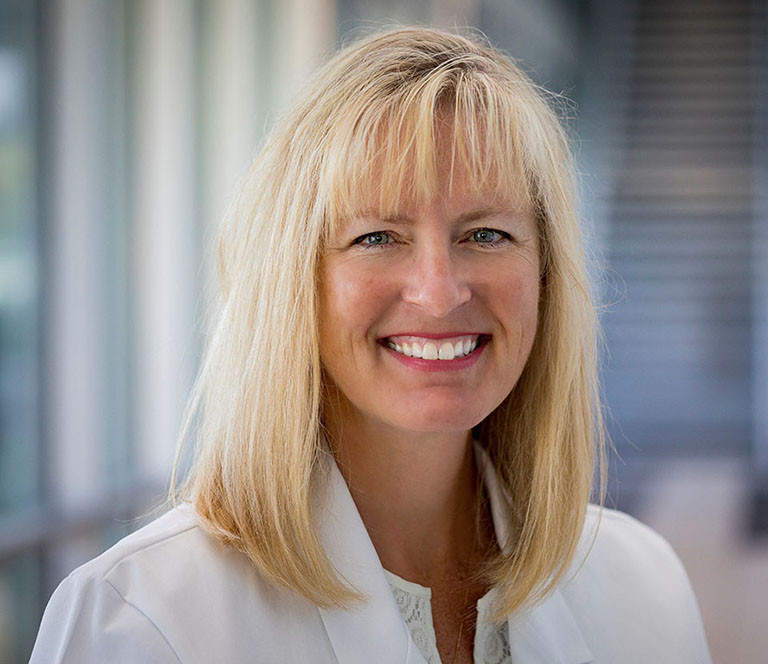
When Karen Thiele, MD, met with a recruiter to discuss her desire to attend medical school, she got a deflating assessment. Sure, Thiele had a nursing degree, but she’d earned it more than two decades earlier.
“Because I’d been out of school for so long, they needed to see I could succeed doing the type of class work I would need for med school,” she says.
Thiele certainly knew about medicine, having worked in intensive care at a Reno hospital and as a flight nurse for a helicopter emergency medical service. There she met her future husband, pilot Jon Thiele, and they had a son. She felt no need for drastic life changes — until a school for paramedics asked her to teach a class.
“I had to go back to the books to remember how to teach basic sciences,” Thiele recalls. “That triggered my desire to go back to school.”
While someone suggested that she become a nurse practitioner, Thiele decided, “I wanted the autonomy and full [medical] knowledge that comes with being a doctor.”
She completed two semesters of graduate biology classes to show the medical school she could do the work and absorbed herself in online video courses, managing to “scrape through” the MCAT exam.
Starting medical school at 46, Thiele soon noticed a significant difference between herself and her classmates: “They have these young minds that are like steel traps. They can remember [things] that I couldn’t. Repetition was the key to learning; I couldn’t just hear something once.”
Also, while many of them were “gunning for honors in every class, I was just happy to pass.”
“You have to be realistic,” she says. “You’ve got a kid at home who needs you.”
However, her life experiences helped her excel in several areas, such as talking to patients about personal health issues. “Having had a 20-year career in health care made all the difference,” Thiele says. “The clinical interview was old hat.”
Thiele gets approached for advice by 40-somethings pondering medical school. She’s supportive but notes that at some point, “you don’t have the length of career ahead of you” to earn back the financial investment. “The chances are, my loans will outlast my career.”
Still, Thiele says she made the right move. She recently became an assistant professor in the Department of Family and Community Medicine at the University of Nevada, Reno, School of Medicine — where she had first consulted that recruiter.
Sarah Bendit
Age: 42
Status: First-year student
University of Michigan Medical School
Ann Arbor, Michigan
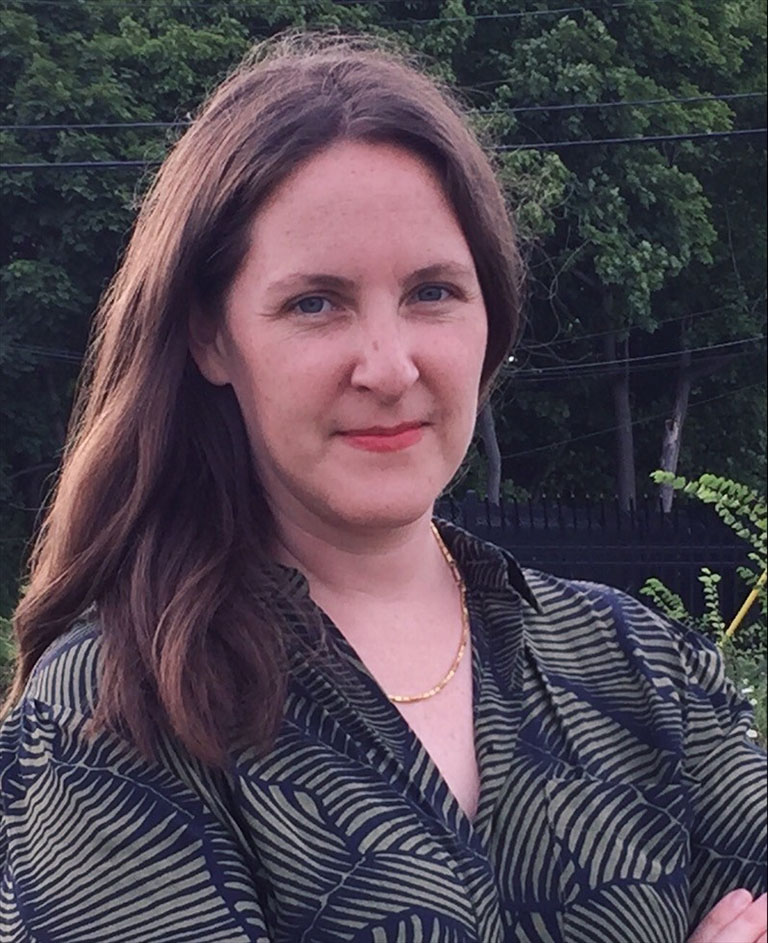
Sarah Bendit liked working with plants, but more and more, she found herself yearning to care for people.
With degrees in natural resources and forestry, Bendit had enjoyed a 15-year career conducting research at the Smithsonian Institution in Washington, D.C., and working on urban forestry and green spaces for New York City. In New York, she routinely educated people, individually and in groups, about plants and plant health.
“I was drawn to medicine out of curiosity and a desire to care for patients,” Bendit says. “I wanted to do meaningful work in a field with lifelong learning.”
After moving back to Michigan to help care for a family member, she found herself ready to take the plunge into medicine. She’s glad she waited.
“It took me a little longer to reflect and know this was the right thing for me,” she says. “It’s so hard to go through medical school, you want to know for sure — to have that certainty and clarity.”
With her scientific background and her completion of the Post-baccalaureate Premedical Program at the University of Michigan Medical School, Bendit felt well-prepared for her return to class.
“It’s a big challenge to go back to, in some ways, being a beginner,” she says, but it’s a challenge she embraces. “I was so excited to be learning.”
Bendit is grateful that her prior career and graduate school experience helped hone her interpersonal skills, such as communication and collaboration. “I’ve seen concretely how my [school] work benefits from working through problems with people coming from different perspectives, working on diverse teams,” she says.
Bendit believes interpersonal and analytical skills developed throughout her career will prove particularly useful as her medical education moves beyond primarily memorizing material to working with patients. She looks forward to integrating medical knowledge with figuring out factors that motivate patients’ decisions about health-related behaviors and medical care.
For those and other reasons, Bendit knows she chose the right time to enter medical school.
“Just knowing myself so much better than I did at 22, in terms of how I learn and think,” she says. “I’ve learned how to learn better.”

